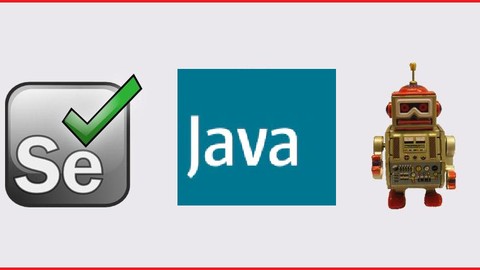
Robot Framework with Java – Selenium
Robot Framework with Java – Selenium, available at $39.99, has an average rating of 4.3, with 38 lectures, based on 35 reviews, and has 203 subscribers.
You will learn about ** Able to do End to End automation on Web Application using Robot Framework *** ** Ready to write user defined keywords using Java Programming *** This course is ideal for individuals who are Manual testers looking opportunity in Functional automation or Automation testers looking to integrate Robot framework with their existing framework It is particularly useful for Manual testers looking opportunity in Functional automation or Automation testers looking to integrate Robot framework with their existing framework.
Enroll now: Robot Framework with Java – Selenium
Summary
Title: Robot Framework with Java – Selenium
Price: $39.99
Average Rating: 4.3
Number of Lectures: 38
Number of Published Lectures: 38
Number of Curriculum Items: 38
Number of Published Curriculum Objects: 38
Original Price: $19.99
Quality Status: approved
Status: Live
What You Will Learn
- ** Able to do End to End automation on Web Application using Robot Framework ***
- ** Ready to write user defined keywords using Java Programming ***
Who Should Attend
- Manual testers looking opportunity in Functional automation
- Automation testers looking to integrate Robot framework with their existing framework
Target Audiences
- Manual testers looking opportunity in Functional automation
- Automation testers looking to integrate Robot framework with their existing framework
Robot Framework is a test automation framework for acceptance testing.
It has easy-to-use tabular test data syntax and it utilizes the keyword-driven testing approach.
Its testing capabilities can be extended by test libraries implemented either with Python or Java(Here we are going to cover java), and users can create new higher-level keywords from existing ones using the same syntax that is used for creating test cases.
We are going to cover,
1. Basic environment setup
2. Automation test cases in different browser
3. Waits
4. Architecture
5. Resource Files
6. User defined keywords
7. Reporting
Course Curriculum
Chapter 1: Introduction & Setup
Lecture 1: Introduction to Robot Framework
Lecture 2: Installation Step 1: Setup JDK
Lecture 3: Installation Step 2: Setup Eclipse
Lecture 4: Installation Step 3: Add Plugin on Eclipse
Lecture 5: Installation Step 4: Setup Create Maven Project and Add Plugin
Lecture 6: Installation Step 5: Add Maven Dependencies
Chapter 2: Start Writing Test Cases
Lecture 1: Different Files in Robot Framework
Lecture 2: Sections in Robot file
Lecture 3: Setup Executable Files
Lecture 4: Rules to write Robot TestCase
Lecture 5: Write First Test Case
Lecture 6: Define and Use Variables
Lecture 7: Use Browser Related Keywords
Chapter 3: Element Locators
Lecture 1: Element Locators & Plugins
Lecture 2: HTML Basics
Lecture 3: CSS Element Locator – Syntax 1
Lecture 4: CSS Element Locator – Syntax 2
Lecture 5: CSS Element Locator – Syntax 3
Lecture 6: CSS Element Locator – Syntax 4
Lecture 7: CSS Element Locator – Syntax 5
Lecture 8: Xpath Element Locator – Syntax 1
Lecture 9: Xpath Element Locator – Syntax 2
Lecture 10: Xpath Element Locator – Syntax 3
Lecture 11: Xpath Element Locator – Syntax 4
Lecture 12: Xpath Element Locator – Syntax 5
Lecture 13: Xpath Element Locator – Syntax 6
Lecture 14: Xpath Element Locator – Syntax 7
Lecture 15: Xpath Element Locator – Syntax 8
Lecture 16: Xpath Element Locator – Syntax 9
Lecture 17: Xpath Element Locator – Syntax 10
Lecture 18: Xpath Element Locator – Syntax 11
Chapter 4: Work on Different Types of Elements
Lecture 1: Work on Textbox
Lecture 2: Work on Button
Lecture 3: Check and Uncheck Checbox
Lecture 4: Select Radio Button
Lecture 5: Click on Link
Lecture 6: Select Value from Dropdown
Lecture 7: Common Examples
Instructors
-
Automation World
Automation expert at Automation World
Rating Distribution
- 1 stars: 5 votes
- 2 stars: 1 votes
- 3 stars: 8 votes
- 4 stars: 6 votes
- 5 stars: 15 votes
Frequently Asked Questions
How long do I have access to the course materials?
You can view and review the lecture materials indefinitely, like an on-demand channel.
Can I take my courses with me wherever I go?
Definitely! If you have an internet connection, courses on Udemy are available on any device at any time. If you don’t have an internet connection, some instructors also let their students download course lectures. That’s up to the instructor though, so make sure you get on their good side!
You may also like
- Best Yoga Instruction Courses to Learn in March 2025
- Best Stress Management Courses to Learn in March 2025
- Best Mindfulness Meditation Courses to Learn in March 2025
- Best Life Coaching Courses to Learn in March 2025
- Best Career Development Courses to Learn in March 2025
- Best Relationship Building Courses to Learn in March 2025
- Best Parenting Skills Courses to Learn in March 2025
- Best Home Improvement Courses to Learn in March 2025
- Best Gardening Courses to Learn in March 2025
- Best Sewing And Knitting Courses to Learn in March 2025
- Best Interior Design Courses to Learn in March 2025
- Best Writing Courses Courses to Learn in March 2025
- Best Storytelling Courses to Learn in March 2025
- Best Creativity Workshops Courses to Learn in March 2025
- Best Resilience Training Courses to Learn in March 2025
- Best Emotional Intelligence Courses to Learn in March 2025
- Best Time Management Courses to Learn in March 2025
- Best Remote Work Strategies Courses to Learn in March 2025
- Best Freelancing Courses to Learn in March 2025
- Best E-commerce Strategies Courses to Learn in March 2025






















